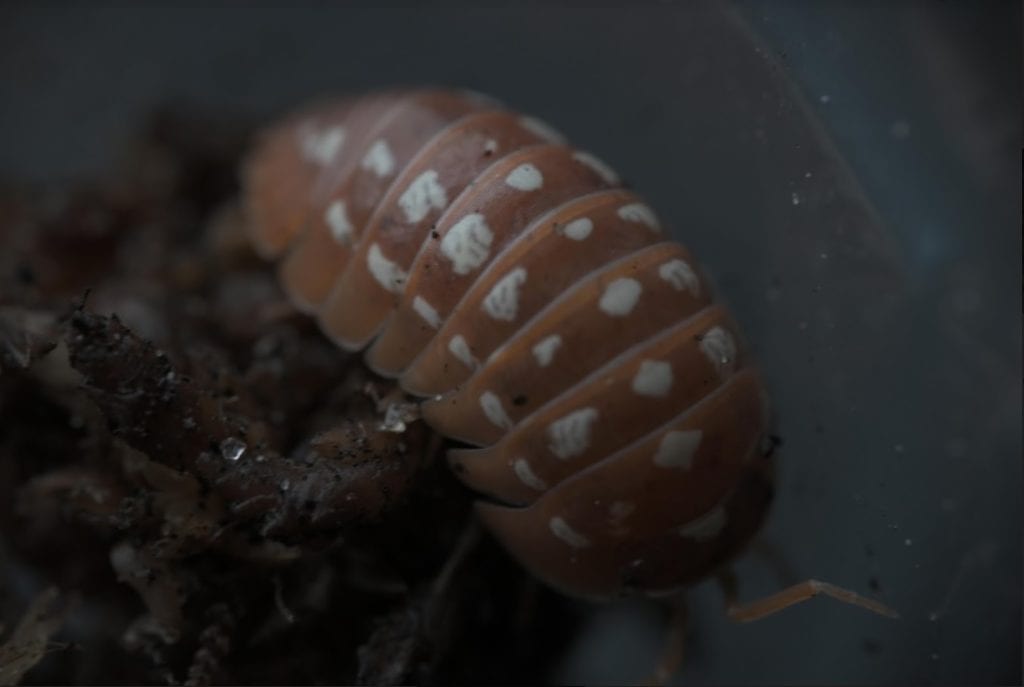If you want to add some interesting microfauna to your bioactive setup, isopods make excellent custodians. Here we break down some of the most common types and what kinds of environments they are best suited for.
If you want to add some interesting microfauna to your bioactive setup, isopods make excellent custodians. Here we break down some of the most common types and what kinds of environments they are best suited for.
With the growing popularity of the bioactive setup endeavour in the amphibian and reptile keeping world has come a fondness for the quirky little invertebrates we call ‘custodians’, ‘microfauna’ or ‘clean-up crew’ (CUC). These can range from morio worms and their adult beetle stage, other beetle species, springtails, to millipedes. Some of the most fashionable are the isopods – also known as woodlice, pillbugs or roly-polys, likely depending on where you are from. They come in a range of colours and varieties, much like our well-loved reptiles and amphibians, as well as providing beneficial services in the micro-environments we create.
With the growing popularity of the bioactive setup endeavour in the amphibian and reptile keeping world has come a fondness for the quirky little invertebrates we call ‘custodians’, ‘microfauna’ or ‘clean-up crew’ (CUC). These can range from morio worms and their adult beetle stage, other beetle species, springtails, to millipedes. Some of the most fashionable are the isopods – also known as woodlice, pillbugs or roly-polys, likely depending on where you are from. They come in a range of colours and varieties, much like our well-loved reptiles and amphibians, as well as providing beneficial services in the micro-environments we create.
Why include isopods?
Aside from looking appealing when spotted milling about in the setup, isopods play a number of beneficial roles in bioactive environments, including:
- Aeration of the soil: while they move around, isopods dig small tunnels in the soil which creates air pockets in the substrate layers. This aids plant roots and helps to prevent the deep soil becoming waterlogged.
- Waste consumption: isopods will eat the faecal material left by your reptiles or amphibians, as well as any decaying plant matter you have included in the substrate. This process provides useful products that plants can utilise.
- Control mites and pests: isopods will eat the eggs of other invertebrates occasionally. This can help prevent pest problems. Keep in mind that they may interfere with other invertebrates you are trying to culture, such as millipedes.
- Supplementary food source: your reptile or amphibian may decide to snack on the occasional unlucky isopod. Their exoskeleton has a high calcium content, and they will provide enrichment and variety in the diet.
Aside from looking appealing when spotted milling about in the setup, isopods play a number of beneficial roles in bioactive environments, including:
- Aeration of the soil: while they move around, isopods dig small tunnels in the soil which creates air pockets in the substrate layers. This aids plant roots and helps to prevent the deep soil becoming waterlogged.
- Waste consumption: isopods will eat the faecal material left by your reptiles or amphibians, as well as any decaying plant matter you have included in the substrate. This process provides useful products that plants can utilise.
- Control mites and pests: isopods will eat the eggs of other invertebrates occasionally. This can help prevent pest problems. Keep in mind that they may interfere with other invertebrates you are trying to culture, such as millipedes.
- Supplementary food source: your reptile or amphibian may decide to snack on the occasional unlucky isopod. Their exoskeleton has a high calcium content, and they will provide enrichment and variety in the diet.
Which type?
You’d be right to think that not all isopods function the same way. Some prefer more humidity while others are more tolerant of dry environments, so depending on whether your bioactive is arid or tropical, you should choose your invertebrates accordingly. Here are some popular isopod species in the hobby and the conditions in which they thrive best.
You’d be right to think that not all isopods function the same way. Some prefer more humidity while others are more tolerant of dry environments, so depending on whether your bioactive is arid or tropical, you should choose your invertebrates accordingly. Here are some popular isopod species in the hobby and the conditions in which they thrive best.
Clown isopods are easily recognised for their bright markings which are thought to be a form of mimicry of the Mediterranean black widow, to deter predators. They come from the coastal areas along the Adriatic Sea, notably Croatia and Montenegro. They are usually found beneath stones and in crevices, where they seek humidity. That being said, these isopods are generally considered a good all-round generalist species, so long as a humid area is available in your bioactive somewhere – which is usually the case even in an arid setup. They reach a maximum size of 21mm and will eat pretty much any organic material available.
Clown isopods are easily recognised for their bright markings which are thought to be a form of mimicry of the Mediterranean black widow, to deter predators. They come from the coastal areas along the Adriatic Sea, notably Croatia and Montenegro. They are usually found beneath stones and in crevices, where they seek humidity. That being said, these isopods are generally considered a good all-round generalist species, so long as a humid area is available in your bioactive somewhere – which is usually the case even in an arid setup. They reach a maximum size of 21mm and will eat pretty much any organic material available.
This species is also a safe choice for almost any bioactive, favouring a 50:50 dry and moist environment. Keeping the humid area of your enclosure maintained will provide a good refuge for these isopods. They don’t like to be too wet, so they likely won’t be ideal for a tropical setup that needs frequent heavy misting. Younger individuals may be eaten by inhabitants, but they are a fairly large species when adult. They also sport quite an appealing colouration of yellow splotches.
This species is also a safe choice for almost any bioactive, favouring a 50:50 dry and moist environment. Keeping the humid area of your enclosure maintained will provide a good refuge for these isopods. They don’t like to be too wet, so they likely won’t be ideal for a tropical setup that needs frequent heavy misting. Younger individuals may be eaten by inhabitants, but they are a fairly large species when adult. They also sport quite an appealing colouration of yellow splotches.
These are the common woodlice we see in Europe and the UK. They are hardy and tolerant of some dry conditions, so they should establish well in a tropical or arid setup as long as conditions aren’t too extreme on either end. While the wild type are a bland slate grey, there are a few colour morphs now available thanks to captive breeding, including red, yellow, albino, “orange dalmatian”, or “magic potion”. Whatever the colour, they will all do the same job in the end!
These are the common woodlice we see in Europe and the UK. They are hardy and tolerant of some dry conditions, so they should establish well in a tropical or arid setup as long as conditions aren’t too extreme on either end. While the wild type are a bland slate grey, there are a few colour morphs now available thanks to captive breeding, including red, yellow, albino, “orange dalmatian”, or “magic potion”. Whatever the colour, they will all do the same job in the end!
These are usually said to be the most common species chosen for tropical setups with high humidity. Dwarf whites are soft bodied isopods that do not roll into a ball, and reproduce asexually. They are small, but hard workers; efficiently cleaning up detritus from the soil and other areas of the environment. T. tormentosa are most popular for keeping alongside amphibians such as poison dart frogs.
These are usually said to be the most common species chosen for tropical setups with high humidity. Dwarf whites are soft bodied isopods that do not roll into a ball, and reproduce asexually. They are small, but hard workers; efficiently cleaning up detritus from the soil and other areas of the environment. T. tormentosa are most popular for keeping alongside amphibians such as poison dart frogs.
These are an excellent choice for arid setups, so long as a small humid retreat is available. P. dilatatus come from Wetsern Europe and North America, and they grow quite large, owing to their name. They eat organic matter similar to most other isopod species and reproduce at a moderate rate. They don’t have a flashy appearance, but are a good choice for their hardiness in drier setups and affordability.
These are an excellent choice for arid setups, so long as a small humid retreat is available. P. dilatatus come from Wetsern Europe and North America, and they grow quite large, owing to their name. They eat organic matter similar to most other isopod species and reproduce at a moderate rate. They don’t have a flashy appearance, but are a good choice for their hardiness in drier setups and affordability.
P. scaber is another common species found throughout Europe and with different colour morphs – such as the popular orange and “dalmatian” varieties. These isopods need 70-80% humidity to thrive and therefore will not do well in an arid environment with low humidity levels. They eat and breed well in captivity.
P. scaber is another common species found throughout Europe and with different colour morphs – such as the popular orange and “dalmatian” varieties. These isopods need 70-80% humidity to thrive and therefore will not do well in an arid environment with low humidity levels. They eat and breed well in captivity.
How to care for isopods
CLOWN ISOPODS (Armadillidium klugii)
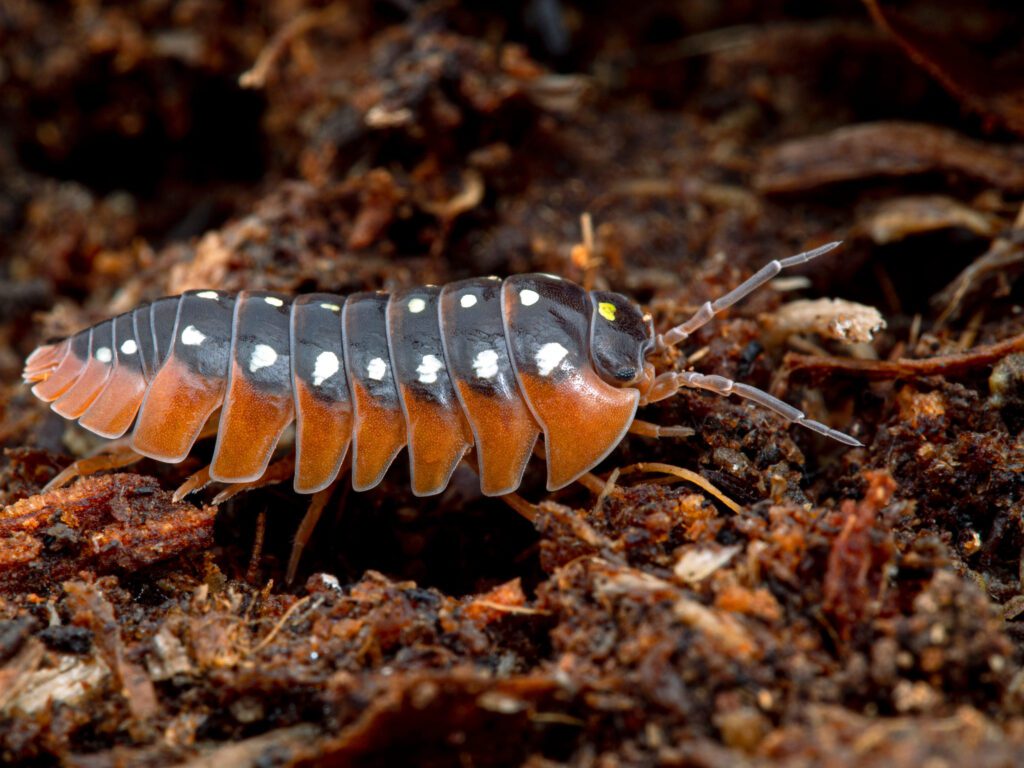
GRANULATED ISOPODS (Armadillidium granulatum)
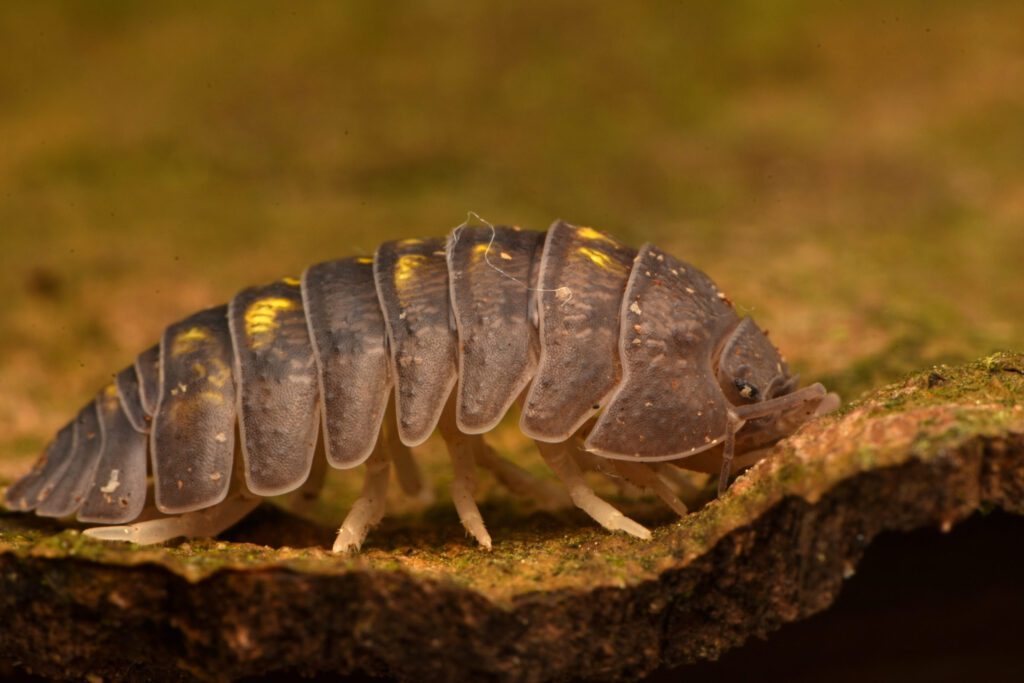
PILL ISOPODS (Armadillidium vulgare)
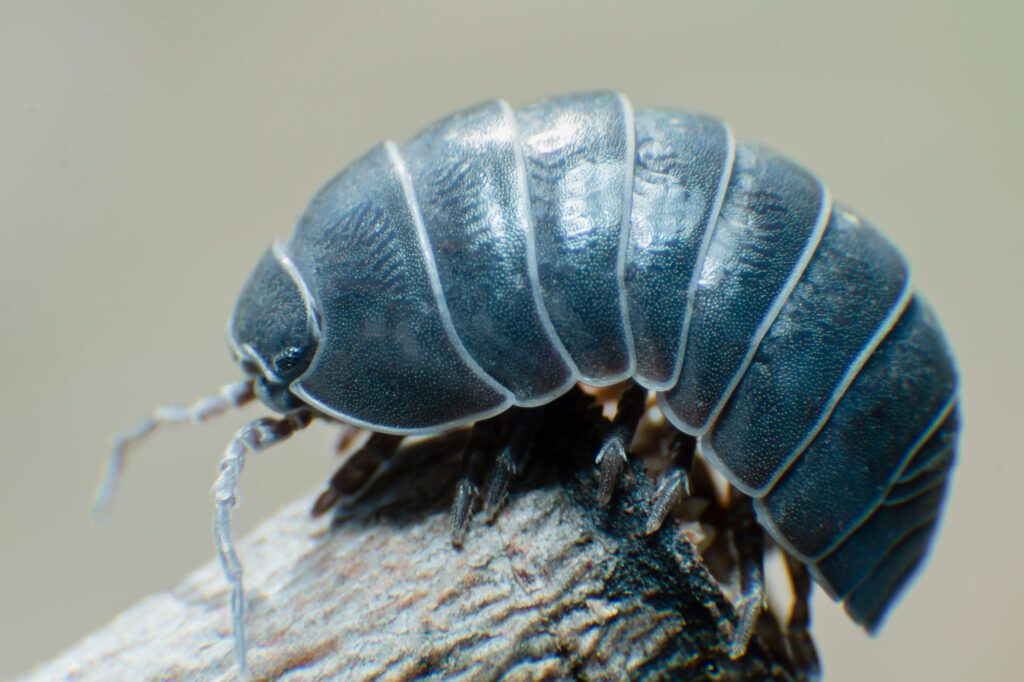
DWARF TROPICAL WHITE ISOPODS (Trichorhina tomentosa)
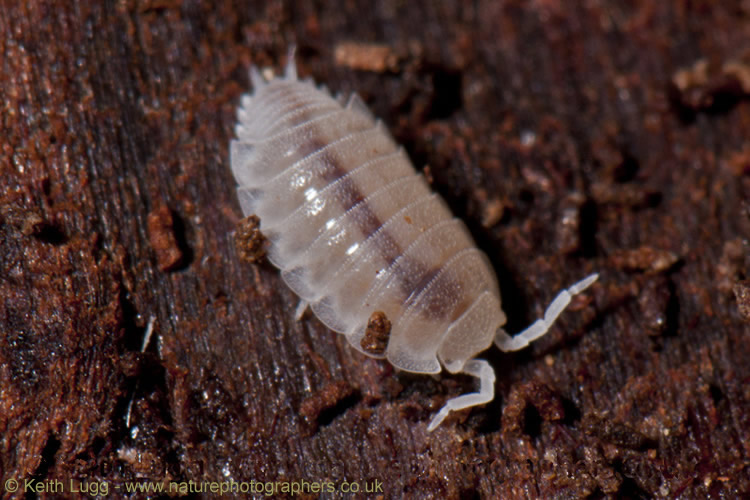
GIANT CANYON ISOPODS (Porcellio dilatatus)
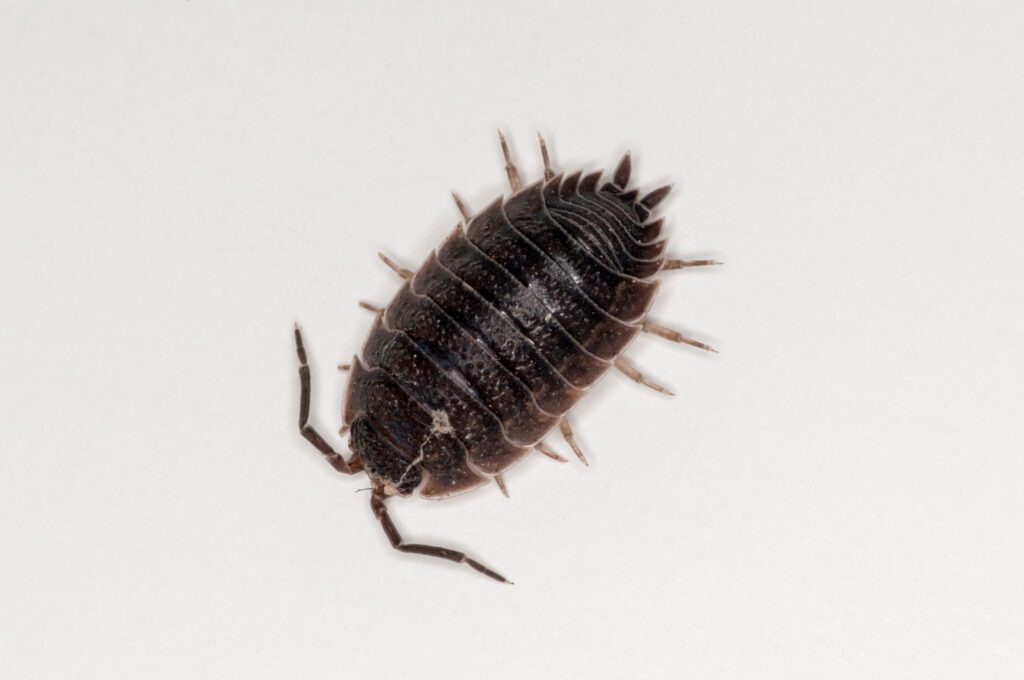
SPECKLED ISOPODS (Porcellio scaber)
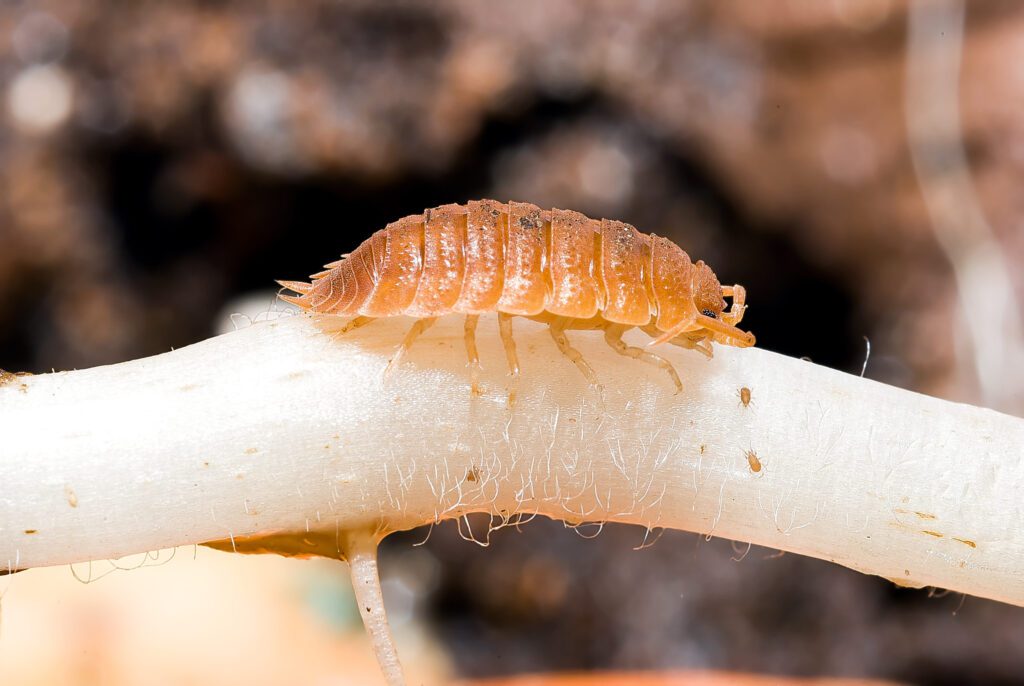
This only scratches the surface of potential isopod species to include in your setup. There are species available from many corners of the world, so you could go the extra mile and select a species that comes from the natural habitat of your own reptile or amphibian. Ultimately it will come down to preference, budget and availability – some of the rarer varieties are hard to come by and priced as such.
This only scratches the surface of potential isopod species to include in your setup. There are species available from many corners of the world, so you could go the extra mile and select a species that comes from the natural habitat of your own reptile or amphibian. Ultimately it will come down to preference, budget and availability – some of the rarer varieties are hard to come by and priced as such.
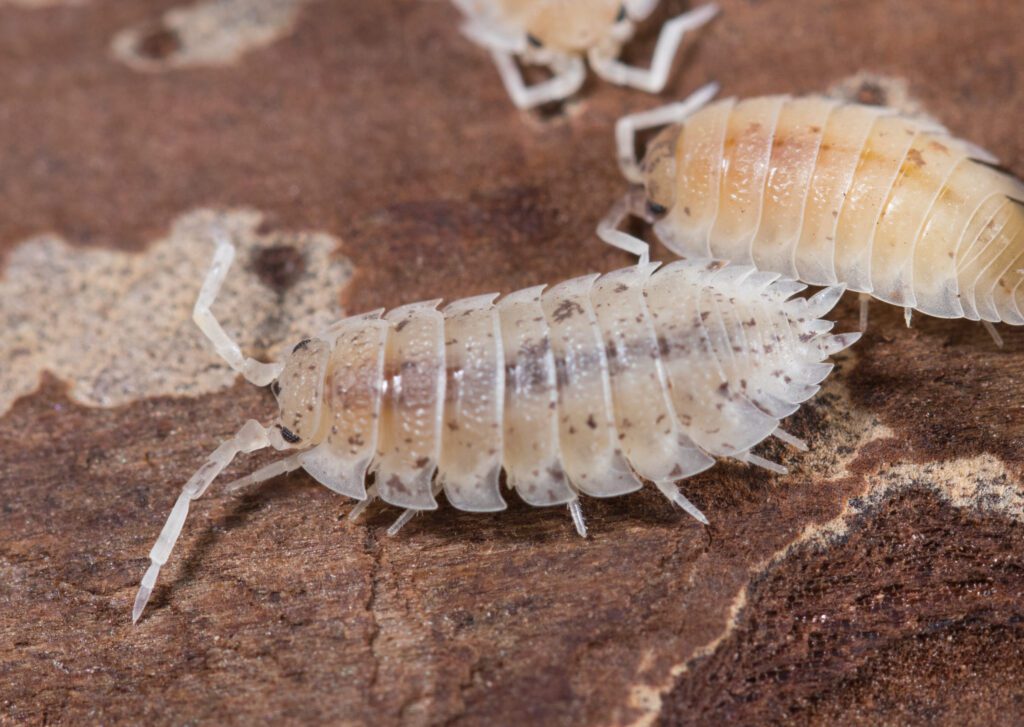
While they differ in environmental conditions, the protocol for introducing isopods is mostly the same. If you are just setting up your bioactive for the first time, it is ideal to introduce the custodians first so that they can become established in the soil. If you are adding them after having your bioactive going for a while, you can keep them established in their delivery container for a short while or a suitable invertebrate container. Introducing them at a time when your reptile or amphibian is not as active may be a good idea to give the isopods a chance to hide before they are eaten. They will most likely retreat to the humid areas of the enclosure.
As for food, isopods will eat any decomposing leaves or wood you have included in the substrate, as well as animal droppings. To supplement, some scraps of fruit and vegetables works well. Specialist food for springtails is also suitable for isopods. Don’t overdo it with food – it will likely go to waste and become mouldy, which is detrimental to the environment. Remember to keep your designated humid areas topped up with water by misting as often as needed. It likely won’t be long before the isopods are settled and even reproducing.
Keeping invertebrates such as these is often a new endeavour for those used to caring solely for reptiles and amphibians, but quickly becomes a rewarding experience watching them become part of the micro community in a bioactive setup. Simulating the natural interactions between animals, plants and soil is a marked achievement which also benefits the animals involved. It will definitely be interesting to see how much more the bioactive practice evolves in the coming years within the hobby.
While they differ in environmental conditions, the protocol for introducing isopods is mostly the same. If you are just setting up your bioactive for the first time, it is ideal to introduce the custodians first so that they can become established in the soil. If you are adding them after having your bioactive going for a while, you can keep them established in their delivery container for a short while or a suitable invertebrate container. Introducing them at a time when your reptile or amphibian is not as active may be a good idea to give the isopods a chance to hide before they are eaten. They will most likely retreat to the humid areas of the enclosure.
As for food, isopods will eat any decomposing leaves or wood you have included in the substrate, as well as animal droppings. To supplement, some scraps of fruit and vegetables works well. Specialist food for springtails is also suitable for isopods. Don’t overdo it with food – it will likely go to waste and become mouldy, which is detrimental to the environment. Remember to keep your designated humid areas topped up with water by misting as often as needed. It likely won’t be long before the isopods are settled and even reproducing.
Keeping invertebrates such as these is often a new endeavour for those used to caring solely for reptiles and amphibians, but quickly becomes a rewarding experience watching them become part of the micro community in a bioactive setup. Simulating the natural interactions between animals, plants and soil is a marked achievement which also benefits the animals involved. It will definitely be interesting to see how much more the bioactive practice evolves in the coming years within the hobby.
